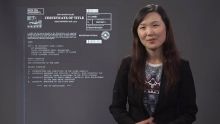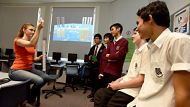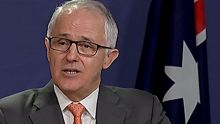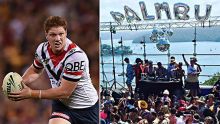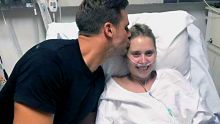We have lift-off! Early on Saturday morning a small integrated sensor made Australian space history. It became the country's first payload sent to the International Space Station.
A successful launch from Japan's Tanegashima space centre at 12.26am lifted the SAGAN sensor hardware on board the H-IIB unmanned rocket. The SAGAN, which contains 12 sensors to run experiments, takes up just one kilogram in a 5.9 tonne cargo of supplies and scientific equipment to the crew on the Space Station.
More NSW News Videos
Sending experiments into space
Solange Cunin is a 23 year old aerospace engineer and is working with high schools to put their experiments on rockets and transferred onto the International Space Station.
The sensor unit will spend a month on board, running the experiments of more than 1000 students from 60 high schools, including West Wallsend High School in the Hunter Valley.
Science teacher Peggy Mangovski said it was an opportunity for 30 of her students "to participate in a real-life space mission".
The idea is the brainchild of Solange Cunin and her company, Cuberider, that is assisting schools develop project-based learning for science education.
At a pre-launch event on level 41 of Barangaroo Tower 2 on Friday, one thrilled West Wallsend boy and the teacher's son, Mason Mangovski, told those assembled: "This is the most exciting thing in my life so far."
Cuberider CEO Ms Cunin at 23 has big plans for the company. "Cuberider's goal is to give every Australian high school student at least one space mission a year," she said.
Cuberider provides teaching support for students to design and code experiments that are then tested in space with the help of NASA astronauts on the ISS.

The project guidelines are aligned with the national curriculum for year 10 and 11. Cuberider hopes this hands-on STEM (science, technology, engineering, maths) program will assist students at a critical moment in their school journey to help reverse the decline in STEM results.
Doing experiments in space isn't cheap. Every hour of space-time costs $1000 - and then there is the cost of hitching a ride on board.

Ms Mangovski, who says her students call her Ms Mango, told Fairfax Media that West Wallsend High was one of 12 schools supported by Regional Development Australia. Her students are using the SAGAN sensor board's UV and infrared sensors to develop a colour palette from space in the design of a school mural.
Data from the SAGAN sensor board will be beamed down from the Space Station every two days, allowing the students to analyse their experiments as they collect information.
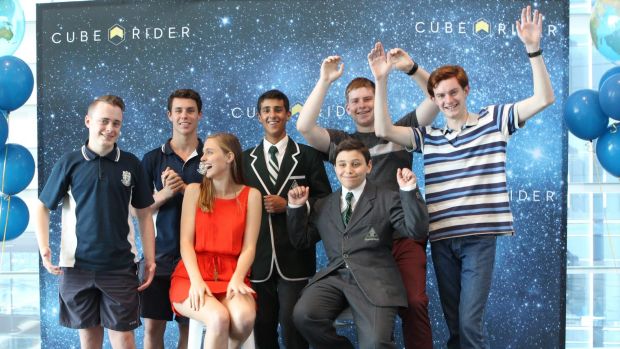
At Friday's Barangaroo event, MCed by Jordan Nguyen, with a live cross to Cuberider co-founder Sebastian Chaoui, students from Trinity Grammar said they were using sensors to test how solar flares affect the acceleration of the Space Station.
The breadth of experiments is astounding. Ms Cunin said the audacity of the science was credit to the teachers.

Students at De La Salle College in Caringbah have developed code to hack the SAGAN onboard camera to detect radiation outside the visible light spectrum. They will use data from this to track radiation on board the Space Station and see if it poses a threat to the astronauts on board.
Japan's #HTV6 cargo craft launched to the station at 8:26am ET (10:26pm Japan time) on 4-day trip to station. https://t.co/C7LVQGQ6Xn pic.twitter.com/45573KvXpP
— Intl. Space Station (@Space_Station) December 9, 2016

Oakhill College students in Castle Hill will use the SAGAN's accelerometer and altimeter to test the actual height and speed of the space station.
One Oakhill student at Friday's event, Andrew Malysiak, said: "The online figures provided by NASA are just approximations." Ms Cunin was delighted. "That's right," she said. "Tell NASA how it's done!"
The Japanese cargo will take at least three days to reach the Space Station. The logistics are impressive. It's like docking a large sedan car with a freight train flying 400 kilometres above Earth where both objects are travelling at 28,000 kilometres an hour, literally faster than a speeding bullet.
最終
— 真之介0113@F6長崎光学観測班 (@shinnosuke0113) December 9, 2016
長崎光学観測班より
長崎県諫早市の白木峰高原にて
H-2Bロケット6号機の光跡#H2BF6 #HTV6 pic.twitter.com/v1gGLVQjCa
The arrival of Cuberider's payload on the Space Station will be the culmination of a dream for Ms Cunin and Mr Chaoui.
Ms Cunin is a UNSW aerospace engineering student. She said: "It's very rewarding to be able to share our love of space with the curious minds of tomorrow's STEM innovators and creators."

